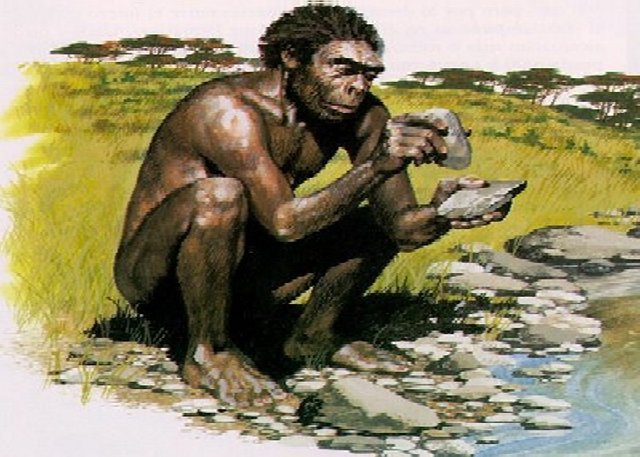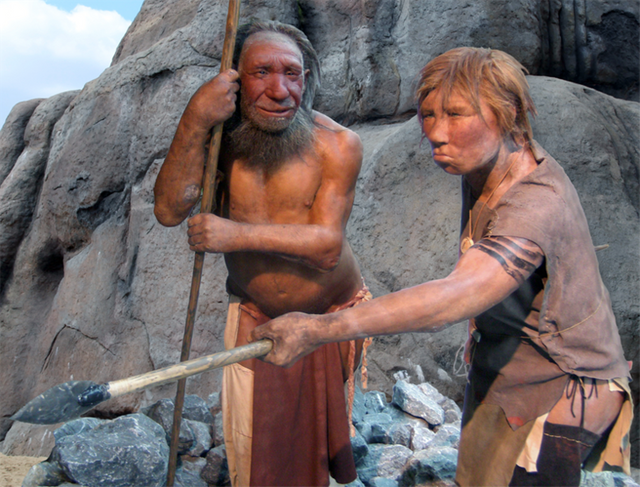Molecular Evidence Of Hybridization In The Evolution of Modern Humans
Hybridization has been known to be a great evolutionary force that have led to emergence and survival of all kinds of species of plants and animals in the world we live in today. This we have learnt from our study of evolutionary biology from time immemorial. It is known that closely related species can mate when they run into one another in the wild or where they are held in captivity. In this regard, brown bears and polar bears have been know to interbreed when they meet2. Same applies to olive baboons and hamadryas baboons that are found in Ethiopia1.

[Source: wikimedia commons. Author: Unknown. CC BY 3.0 licensed]
Hybridization enables acquisition of new traits necessary for survival in a challenging prevailing abiotic environment. Most commonly, the hybrid resulting from the mating of two closely related species acquires the traits of both parents, a development that could turn out to be an evolutionary force, conferring on the hybrid the ability to survive in an environment that both of its parent species may not survive in. It was reported in July 2015 that hybrid coral could survive in a busy shipping channel, which its parents cannot do2.
Human — Hominids interbreeding and its genetic evidence
True as is the fact that hybridization has been part of evolution of life, it is weird to think that our ancestors, like other animals, were involved in copulation with now-extinct hominids — human-like individuals who are not quite humans. Yet, as unbelievable as this is, it is true. Hence, exploring the molecular evidence supporting this claim shall form the theme of this article, while attempting to provide credible answers as what could have led to the extinction of such human-like beings despite their close proximity to modern humans in terms of intelligence and morphology.
Since 2010, there has been increasingly genetic evidence of separate interbreeding events between modern humans (Homo sapiens) and other now-extinct hominids2 during the middle Paleolithic and early upper Paleolithic. One of such species that may have interbred with modern humans is Neanderthals going by the result of 2010 sequencing of Neanderthal genome during which it was shown that as much as 1 to 4 percent of the DNA of non-Africans might have been inherited from Neanderthals1. Neanderthals, an extinct species of archaic humans that died out some 40000 years ago, are known to have originally evolved in Europe before some later migrated to Asia3. In comparison with modern humans, Neanderthals were said to be stockier, having shorter legs than humans but with bigger bodies. All these features, according to Bergmann's rule, are adaptations that enable them to preserve heat in cold climates being their natural habitats3.
A genetic study published in 2012 showed that Neanderthals are not the only extinct hominid that interbred with modern humans in the past. There is another extinct species known as Denisovans which was said to have been discovered following the analysis of DNA extracted from the tip of a child's finger bone by a scientific group led by Johannes Krause of Tubingen University, Germany. The bone for the analysis was discovered in 2008 at Denisova Cave in the Altai Mountains, Siberia. And was said to be 30,000 to 50, 000 years old which coincided with the time modern humans and Neanderthals lived. However, on comparing the finger bone's DNA with those of modern humans and Neanderthals, it was found that there was no match whatsoever and so the finger bone couldn't have come from either modern humans nor Neanderthals. And thus lend credence to the belief that some other kind of hominid must have also been living in the region as at that time1. Denisovans lived in Asia, though some later migrated to Europe. Again, physical characteristics of an adult molar tooth which was also found in the same Denisovan cave where the finger bone was discovered, showed it's neither from a modern human nor a Neanderthal. And a study carried out to analyze the adult molar tooth DNA showed it to be very similar to the finger bone's DNA, confirming that both must have come from the same individual who was neither a modern human nor a Neanderthal. And so must be a Denisovan, an entirely different species1. David Reich of Harvard University and his colleagues furthermore compared Denisovan DNA with modern human DNA and concluded that as much as 5 percent of the DNA of people living in Melanesia could be from Denisovans—evidence of more interbreeding. Another study confirmed that Australian aborigines, Polynesians and other people of Oceania also had a Denisovan heritage. Now it appears that Southeast Asians do as well. ||Source This evidence supporting hominid — modern human interbreeding validates the supposition of the expansion of modern humans out of Africa because none of the now-extinct hominids is ancestry to Africa4. Both Neanderthals and Denisovans are of Eurasian ancestry. Modern humans who migrated to Eurasia from Africa were said to have shared the continents with different species of hominids for about 5000 years before the hominids died out eventually. Based on this, it is evident that interbreeding between modern humans and other human-like species of hominids must have taken place within this interim. Hence the previous hypotheses that anatomically modern humans migrated to Eurasia and replaced indigenous now-extinct hominins without interbreeding have been invalidated by these new findings and so no longer hold sway. Mating did occur, conferring the resulting hybrids the ability to withstand the indigenous diseases, resulting to further expansion into the hinterlands. Previously, it was thought that hybridization never occurred in Africa since none of the now-extinct species of hominins are indigenous to Africa. But this fact has since been disproven, however. The results of genetic analysis of a 4,500-year-old skull that was discovered in Ethiopia, showed that there was a huge wave of migration from Eurasia into Africa some 3000years ago5. When these foreigners came into Africa, there was profound social interaction between them and native Africans following which mating occurred, giving rise to hybrid individuals possessing genes and alleles from different species of hominids. The study was published in the Journal Science and as much as 25% of DNA of modern humans is traceable to this event5. In conclusion, it can be said that the widespread genetic diversity as seen in the world today was product of interbreeding between modern humans and now-extinct different species of hominids. Hybridization has proven to be very helpful tool for favorably adapting in new lands in the era humans were expanding into foreign places. Thank you. Truly yours,
[Source: wikimedia commons. Author: Frank Vincent. CC BY-SA 3.0 licensed]

[Source: flickr commons. Author: Erich Ferdinand. CC BY 2.0 licensed]Hominid genes traced to Africa
References
@sciencetech
STEM contributor
Thanks for the information. You made us know that the widespread genetic diversity as seen in the world today was product of interbreeding between modern humans and the extinct different species of hominids.
Thanks for being here and leaving such a wonderful comment.
@sciencetech
STEM contributor
This post has been voted on by the steemstem curation team and voting trail.
There is more to SteemSTEM than just writing posts, check here for some more tips on being a community member. You can also join our discord here to get to know the rest of the community!
This is an interesting and informative article about our ancestry.....Nice work
Thanks bro
Hi @sciencetech!
Your post was upvoted by utopian.io in cooperation with steemstem - supporting knowledge, innovation and technological advancement on the Steem Blockchain.
Contribute to Open Source with utopian.io
Learn how to contribute on our website and join the new open source economy.
Want to chat? Join the Utopian Community on Discord https://discord.gg/h52nFrV